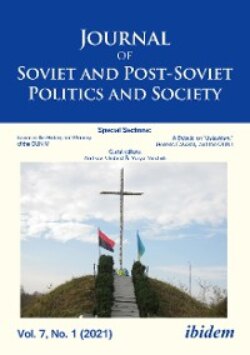Читать книгу Journal of Soviet and Post-Soviet Politics and Society - Группа авторов - Страница 6
Debating Ukrainian Nationalism’s World War II Record
ОглавлениеThese and other recent peer-reviewed papers have provided the background for the start of a separate series of—at least, two—JSPPS special sections under the title “A Debate on ‘Ustashism,’ Generic Fascism, and the OUN,” the first installment of which is printed in this issue.4 This discussion complements our earlier research articles—including the present ones—on the OUN, yet markedly departs from traditional collected editions. The ustashism debate in JSPPS, to be sure, also refers to a plethora of empirical details and contains some relevant quotes, as ordinary academic papers and the present series of special sections do.
Yet, the ustashism debate consists of uniformly non-reviewed and largely disputational commentaries rather than research articles proper. Within the series “A Debate on ‘Ustashism’, Generic Fascism, and the OUN,” a variety of scholars in the fields of comparative fascism, East European right-wing extremism, and Ukrainian ultra-nationalism discuss a 2015 seminal paper by Oleksandr Zaitsev (Ukrainian Catholic University at L’viv) on the OUN’s “ustashism,” in the journal Communist and Post-Communist Studies.5 A first response to Zaitsev’s paper was published in 2020 in JSPPS in the form of a research paper by two specialists on the Ustaša, Tomislav Dulić and Goran Miljan (Uppsala University), who focused on the relationship between fascism and abolitionism.6 For the “Debate on ‘Ustashism’, Generic Fascism and the OUN,” we have asked a number of experts on the East European far right, historical Ukrainian nationalism, and comparative fascism to voice their opinion on the different approaches to the OUN by Zaitsev, and Dulić/Miljan.
In our 2017, 2018, and 2020 introductions to the first three sections “Issues in the History and Memory of the OUN,” freely accessible on the JSPPS website, we reflected upon topical events in Ukraine at that time, as well as on ongoing memory production and historical debates related to historical Ukrainian radical nationalism. We briefly chronicled and contextualized Ukraine’s peculiarly evolving Vergangenheitsbewältigung (coming to terms with the past) before and after the Euromaidan.7 In our last introduction of early 2020, we noted that the election of Volodymyr Zelens’kyi as President of Ukraine and the departure of the incumbent Petro Poroshenko, contrary to some observers’ expectations, had not resulted in an about-face when it came to governmental Ukrainian memory approaches with regard to the OUN. In early 2021, this statement still holds.
The new director of the Ukrainian Institute of National Remembrance (UINP) attached to the Cabinet of Ministers of Ukraine, Anton Drobovych, appointed in December 2019, changed the vector of the Institute’s work only moderately. Under Drobovych’s leadership, the UINP’s main activities have entailed a stronger focus on promotion of some relatively new themes in government-supported national memory like, for instance, such historic figures as the legendary football player and coach Valeriy Lobanovs’kyy (1939–2002), or the world-famous avant-garde artist and art theorist Kazimir Malevich (1879–1935). By early 2021, the policies of the Remembrance Institute’s new leadership since 2019 have not produced any debates comparable to the heated discussions prompted by the 2014–2019 UINP head Volodymyr V’iatrovych’s advocacy for a hagiographic OUN commemoration.8
